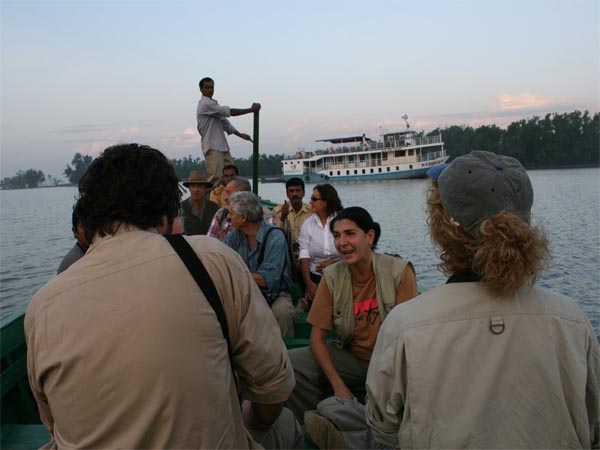Foreign arrivals very less than outbound tourists
Manzurul Alam Mukul || risingbd.com

Simply speaking, outbound tourism is when a resident of a given country leaves that country to visit another one. It can be for holidays, business, trip, etc. On the other hand, inbound tourism is when a non-resident or foreigner visits a given country.
For example, from an American perspective, if an American visits Germany, that is considered to be outbound tourism, but if a German visits the United States, that is considered to be inbound tourism.
Tourism is an industry which includes all kind of economic activities or businesses related to travels, for recreational, leisure or business purposes, made by a person or persons that stays in places, at least two nights, outside their usual environment.
Inbound and outbound tourism have an important impact on a country`s financial health. When a country attracts a lot of inbound tourism, the tourists spend money on souvenirs, hotels, dining and other amenities. This creates jobs, and through consumption taxes, it adds additional money to that country’s coffers.
Outbound tourism generates some money in the country of origin-outbound tourists buy things such as travel insurance, plane tickets and new travel clothing from their home country. However, ultimately, outbound tourism takes financial resources out of the home country and gives them to the destination country.
If a country has more inbound than outbound tourism, it has a travel trade surplus, and a country with a travel trade surplus can consider tourism to be a very lucrative export. However, that does not mean that a country should not encourage outbound tourism. There are intangible effects of both inbound and outbound tourism, and these include learning about the surrounding world and fostering positive relationships between countries.
On the other hand, according to statistics of Bangladesh Tourism Board (BTB), a total of 276,583 tourists visited Bangladesh in 2013, 586,333 tourists in 2012, 593,722 tourists in 2011, 527,316 tourists in 2010 and 477, 026 tourists in 2009.
India tops the list of inbound tourists in Bangladesh, followed by British-Bangladeshis, Chinese, Australians and Canadians. According to BTB, a total of 160,230 Indians visited Bangladesh followed by 83,100 British-Bangladeshis in 2012. Indians who left this part of the country before partition mainly come to Bangladesh to see their ancestral properties and houses. Some 400 Indians from Agartala and Tripura visit Bangladesh every day.
Tourism sector sees a bright prospect
Bangladesh has enormous potential to develop tourism because of its sattractive natural beauty and rich cultural heritage. Bangladesh is endowed with so many natural beauties like sea beaches, parks, forests, eco tourism, wild life sanctuaries, hill tracts areas, tea estates, island, etc. Moreover, two international standard sea ports, hundreds of museums, attract people from all over the world.
Bright historical background has blessed Bangladesh with so many historic places, heritages, monuments, historical buildings and archaeological sites. Furthermore, picnic spots, bridges, amusement parks, mosques, tombs, temples & monastery, and churches have made the country an ideal place for the tourists.
Bishwa Ijtema, tombs and other pilgrim spots have encouraged people of religious tourism. Glory historic background and the combination of huge cultural ingredients welcome the interest group of education tours. Cheap labor, huge potentiality and availability of raw materials attract people of business tourism.
The Bangladesh travel and tourism sector posted 25 per cent growth in 2014. Earnings from the travel and tourism sector reached some 150 million US dollars in 2014 compared to 121.45 million US dollars in 2013, according to statistics of Bangladesh Parjatan Corporation (BPC).
The earnings from the sector recorded at 100.75 million US dollars in 2012, 83.73 million US dollars in 2011 and 79.83 million US dollars in 2010 and 83.9 million US dollars in 2009.
Bangladesh can attract Buddhist travelers
South Asia, most notably Bangladesh, Bhutan, India, Nepal and Sri Lanka, is recognised as the heartland of Buddhism.
Presently, 1.3 million tourists visit different Buddhist sites in Nepal, Bhutan and India while Myanmar received 3.5 million Buddhist tourists in 2014 and set a target of getting 7.5 million by 2020.
Bangladesh has over 500 ancient Buddhist relics and archeological sites and it can take a share of 1.3 million annual Buddhist travelers roaming India, Bhutan and Nepal.
Despite having historic Buddhists, Bangladesh is getting a tiny portion from Buddhists tourist circuit that roam around the subcontinent.
According to the Indian Bureau of Statistics about 2.25 lakh foreign tourists visited Gaya in 2014 while over two lakh in Bodhgaya, 1.25 lakh in Nalanda and 1.25 lakh in Lumbini, the birth place of Lord Buddha.
But only 3,241 foreign tourists visited three ancient Buddhist sites -- Paharpur, Mahasthangath and Moinamoti in 2014.
Realising the huge potential of Buddhists tourism, the Bangladesh government organized a two-day international conference on Buddhist Circuit with participation of 13 Buddhist populated countries in the capital on October 27-28 to prepare the road map.
Experts say Bangladesh can earn US$ 6 billion dollars in revenue a year if it can attract 1.5 lakh foreign tourists to visit Buddhist heritage sites annually.
The United Nations has already announced it will support Bangladesh for improvement of infrastructure of its over 500 ancient Buddhist relics and archeological sites to attract a large number of Buddhist tourists out of 480 million Buddhist followers around the world.
UN has supported Cambodia in improving its historic Buddhist sites and presently Cambodia has a share of two million Buddhist tourists annually.
Therefore, Bangladesh has ample opportunity of become as a tourist nation. Tourism, mostly a service industry, is more labor-oriented than other sectors of production.
Experts propose that Cox’s Bazar and Kuakata sea beaches need to be upgraded on priority basis and more steps are needed for the Sundarbans, the largest mangrove forest in the world, to attract increasing number of tourists both from home and abroad.
Risingbd/Oct 30, 2015/Mukul
risingbd.com





































